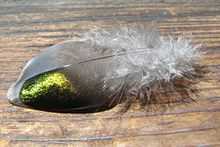Common bronzewing
| Common bronzewing | |
|---|---|
 | |
| A male common bronzewing in Queensland | |
 | |
| Female | |
| Conservation status | |
| Scientific classification | |
| Kingdom: | Animalia |
| Phylum: | Chordata |
| Class: | Aves |
| Order: | Columbiformes |
| Family: | Columbidae |
| Genus: | Phaps |
| Species: | P. chalcoptera |
| Binomial name | |
| Phaps chalcoptera (Latham, 1790) | |
The common bronzewing (Phaps chalcoptera) is a species of medium-sized, heavily built pigeon.[2] Native to Australia and one of the country's most common pigeons, the common bronzewing is able to live in almost any habitat, with the possible exception of very barren areas and dense rainforests.[3]
Description
Males of the species have pale-yellow to yellow-white foreheads, and pink breasts.[2][4] Both males and females have an easily discernible white line around and proximate to their eyes. Common bronzewings also have patches of red, blue and green on their wings, a feature which is characteristic of all bronzewing pigeons.[2][4] Young birds are usually duller in colour and browner than the mature common bronzewing.
Rarely found far from a source of water, common bronzewings either travel alone or in pairs or in flocks, and are usually cautious, making approach by humans or other animals difficult.[2] Common bronzewings are, on average, between 30 and 36 centimetres (12–14 in) in length.[3]

Feeding
The common bronzewing's diet primarily consists of seeds and all varieties of vegetables. It searches for food in small groups. The search can sometimes last for days, and, since the pigeon must drink frequently, it utilizes watering holes or any other available source of water.[2]
Breeding

Common bronzewings construct a rough nest of twigs and sticks, which is placed low down in a tree or bush. The eggs hatch after a period of roughly 14 to 16 days, after being incubated by both the male and the female. Both parents share the responsibility of caring for the young. In common with other pigeons, common bronzewings release a milky substance from their crop to feed their young.[4]
References
| Wikimedia Commons has media related to Phaps chalcoptera. |
| Wikispecies has information related to: Phaps chalcoptera |
- ↑ BirdLife International (2012). "Phaps chalcoptera". IUCN Red List of Threatened Species. Version 2013.2. International Union for Conservation of Nature. Retrieved 26 November 2013.
- ↑ 2.0 2.1 2.2 2.3 2.4 "Birds in Backyards - Common Bronzewing". Retrieved 19 June 2007.
- ↑ 3.0 3.1 "Wildlife of Sydney website". Archived from the original on 29 August 2007. Retrieved 19 June 2007.
- ↑ 4.0 4.1 4.2 "Common Bronzewing (Phaps chalcoptera)". Australian Museum Online. Retrieved 19 June 2007.
